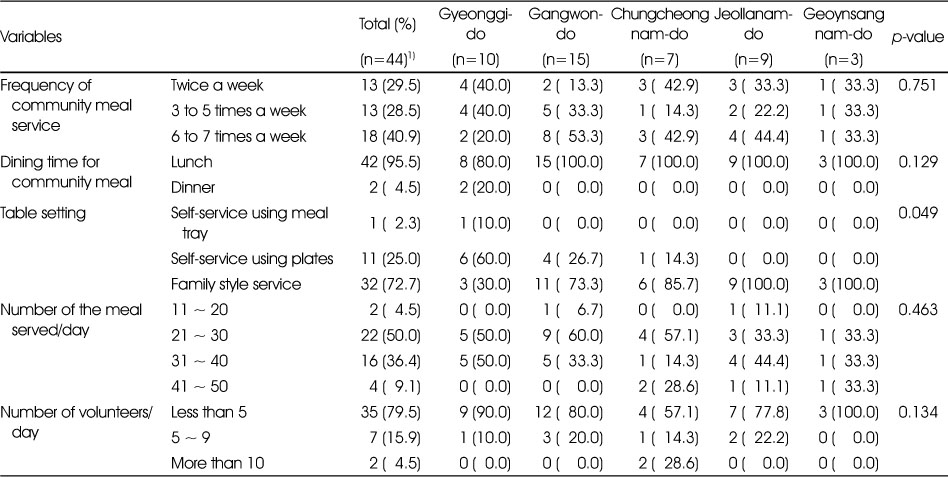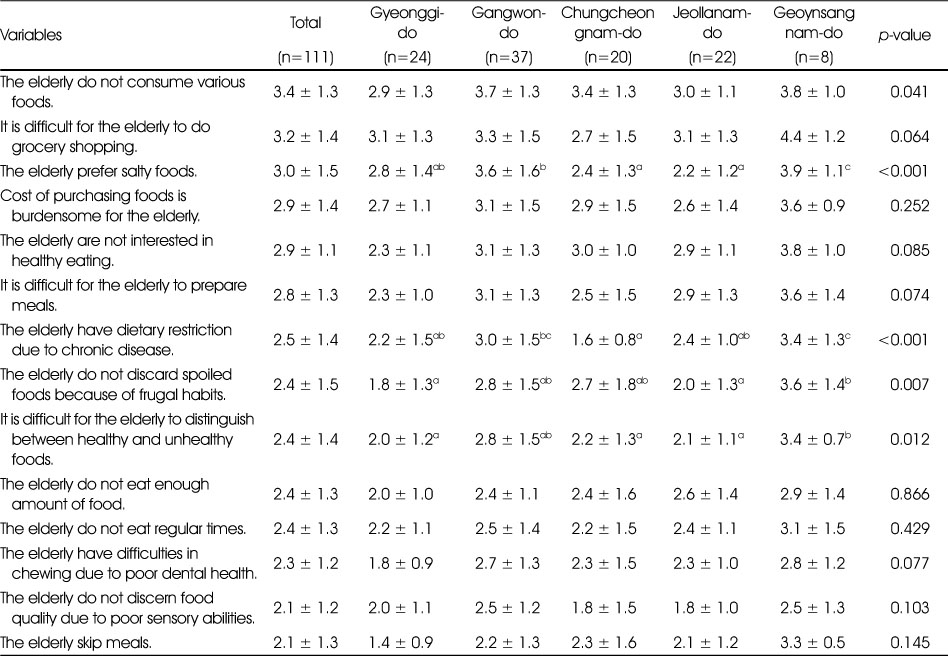References
1. Statistics Korea. Statistics list [Internet] Statistics Korea; 2018. cited 2019 May 10. Available from:
https://www.kostat.go.kr/.
2. Kang NE, Lee JY. The analysis of effect on nutrition education program for the elderly in Sung-nam area. Korean J Food Nutr 2005;18(4):357–366.
3. Heo YR, Shin JH, Kim KS, Kim BH. Development and application of a community-based meal program model for the elderly in rural area. J Korean Diet Assoc 2008;14(1):23–35.
4. Kim Y, Seo SH, Kwon OR, Cho MS. Comparisons of dietary behavior, food intake, and satisfaction with food-related life between the elderly living in urban and rural areas. Korean J Nutr 2012;45(3):252–263.
5. Kim HY, Kim GH, Kim HR, Kim YS. Menu development and application for rural elderly of Gangwon and Chungnam areas at agricultural off-season. Korean J Community Living Sci 2009;20(3):423–435.
6. Lee Y, Choi Y, Park HR, Song KH, Lee KE, Yoo CH, et al. Comparative analysis of dietary behavior and nutrient intake of elderly in urban and rural areas for development of “Village Lunch Table” program: Based on 2014 Korea National Health and Nutrition Examination Survey data. J Nutr Health 2017;50(2):171–179.
7. Chun JD, Ryu SY, Han MA, Park J. Comparisons of health status and health behaviors among the elderly between urban and rural areas. J Agric Med Community Health 2013;38(3):182–194.
8. Byker Shanks C, Haack S, Tarabochia D, Bates K, Christenson L. Factors influencing food choices among older adults in the rural western USA. J Community Health 2016;42(3):511–521.
9. Chae HS, Yoon SD, Lee GS, Kim HC. Effectiveness evaluation of the education program to take care of the elderly in the rural area. J Agric Ext Community Dev 2009;16(1):1–20.
10. Yoon JS, Song MK, Lee HJ, Lee SY, Cho HK, Choi YJ. An evaluation of the dietary status for developing assistance programs for daily lives of elderly individuals in rural Korea. Korean J Community Living Sci 2014;25(2):163–173.
11. Kim HY, Park CE, Lee HJ, Park YH, Lee JY. A study on the menu development for the elderly during busy farming season in Gyeongbuk Andong. J Korean Soc Food Sci Nutr 2009;38(10):1381–1391.
12. Chung EJ, Shim EG. Comparison of health status and nutrient intakes of elders who participated in mow and free congregate meal services. J Korean Soc Food Sci Nutr 2007;36(11):1399–1408.
13. Lee KE, Yi NY, Park JY. Food safety knowledge and home food safety practices of home-delivered meal service recipients. J Korean Soc Food Sci Nutr 2009;38(5):618–625.
14. Cha GH, Kim JS, Park HR, Park HS, Youn SJ, Park JH. A study on the eating habits and food preference of the elderly in Jeonju, North Jeolla province. Food Eng Prog 2016;20(1):35–52.
15. Kim SW, Shin JH, Sohn SJ, Heo YR, Kang MG. Effect of nutrition support program for the elderly in a rural community. J Agric Med Community Health 2009;34(1):113–123.
16. Park JS, Oh YJ. The effects of a health promotion program in rural elderly on health promotion lifestyle and health status. J Korean Acad Nurs 2005;35(5):943–954.
17. Park MY, Chun BY, Joo SJ, Jeong GB, Huh CH, Kim GR, et al. A comparison of food and nutrient intake status of aged females in a rural long life community by the stage model of dietary behavior change. Korean J Community Nutr 2008;13(1):34–45.
18. Park PS, Chun BY, Jeong GB, Huh CH, Joo SJ, Park MY. The effect of follow-up nutrition intervention programs applied aged group of high risk undernutrition in rural area (I). Korean J Food Cult 2007;22(1):127–139.
19. Choi YJ, Kim C, Park YS. The effect of nutrition education in program in physical health, nutritional status and health-related quality of the elderly in Seoul. Korean J Food Cult 2007;40(3):270–280.
20. Park HJ, Lim BK, Kim WY. Effect of food commodity supplementary program for low income elderly people. Korean J Food Cult 2007;22(1):149–156.
21. Kim MK, Han JI, Chung YJ. Dietary behavior related to salty food intake of adults living in a rural area according to saline sensitivity. Korean J Nutr 2011;44(6):537–550.
22. Kawano Y. Salt, hypertension, and cardiovascular diseases. J Korean Soc Hypertens 2012;18(2):53–62.
23. Lee MS. The relationship between dietary behaviors/health risk factors and preference for salty taste among Korean elderly people living in rural areas. Korean J Community Nutr 2014;19(5):448–458.
24. Han KH, Choi MS, Park JS. Psycho-social, nutritional status and meal service utility patterns by living arrangements of the elderly participated in meal service. Korean J Community Nutr 2004;9(5):615–628.
25. Ye M, Chen L, Kahana E. Mealtime interactions and life satisfaction among older adults in Shanghai. J Aging Health 2017;29(4):620–639.
26. Lim JG. The effects of social support on life satisfaction among the elderly: focusing on the difference between rural and urban area. Korean J Soc Welf Res 2013;38:217–240.







